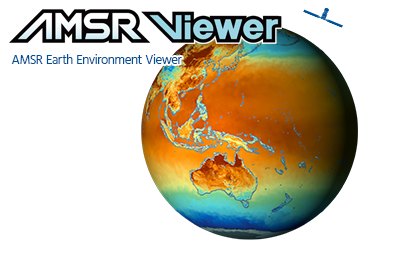
The AMSR Viewer has provided daily images of brightness temperature and estimated geophysical data since June 2002. The AMSR Viewer has such functions as map zoom-in/out and specifying the date of observation so you can easily select the region or season you want to see.
The AMSR is a satellite sensor that observes microwave signals naturally emitted from various materials on the Earth. Those data enable us to estimate various geophysical quantities related to the water cycle. The AMSR Viewer can display images of observation data and water-related geophysical quantities up to a maximum of 3 layers.
Thank you for your interest in JAXA's Earth observation. JAXA has released many Earth observation sites such as the Himawari Monitor and GSMaP. For details, please see JAXA for Earth.
Coastline roughness is different between "Coastline 1:50m" and "Coastline 1:10m". The "Coastline 1:50m" is coarser and the "Coastline 1:10m" is finer. The "Coastline 1:10m" has a large data size, so it will take some time to display it. Normally, the user will choose the “Coastline 1:50m". If you feel the coastline is rough when you zoom in, please use the “Coastline 1:10m".
There are two types of AMSR data, the standard and near real-time products. When "Early ver." is displayed on the color scale panel, it means that the image was created using a near real-time product. Since near-real-time products attach importance to their rapidity, they are less accurate than the standard product.
An image created using the near real-time product will be replaced when the image of the standard product is created.
Please refer to the following table. The accuracy and measurement range of AMSR-E data are the same as of the AMSR2 data.
Both are sea surface wind speed data. "Sea wind speed" has better resolution and accuracy, but there is no data for rain, snow, and thick-cloud areas. "All-weather wind speed" has poor resolution and accuracy but is characterized by less missing data due to rain, snow, or thick clouds.
Both data are sea surface temperature data. Since "10GHz Sea Surface Temperature" has a finer resolution, data closer to the coastline is available than for "Sea Surface Temperature". Please note that, for "10GHz Sea Surface Temperature", the accuracy is low in cold seawater below 9 degrees Celsius.
The type of satellite sensor is different. The AMSR Viewer uses the “Sea Surface Temperature" estimated using the data obtained by a microwave radiometer (AMSR-E, AMSR2). The microwave radiometer has a coarse resolution of several tens of kilometers, but it is possible to estimate the sea surface temperature even in the presence of clouds. On the other hand, the SHIKISAI (GCOM-C) has an optical sensor called SGLI. The optical sensor cannot estimate “Sea Surface Temperature" under clouds, but the SGLI can be estimated with a finer resolution of about 250 m.
Please refer to the following document
The period of data published on the AMSR Viewer is as follows.
You can download the time series data at any specified point on the map as a CSV file. For details, please see the AMSR Viewer User's Guide. User registration is required to download.
Please refer to the following page.
There is no problem. Please confirm the terms of use of AMSR Viewer before using.
Please register again from here. The old password is removed, and a new password is issued.